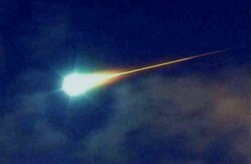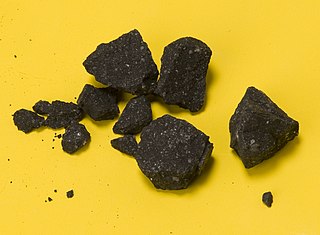Related Research Articles

A meteorite is a rock that originated in outer space and has fallen to the surface of a planet or moon. When the original object enters the atmosphere, various factors such as friction, pressure, and chemical interactions with the atmospheric gases cause it to heat up and radiate energy. It then becomes a meteor and forms a fireball, also known as a shooting star; astronomers call the brightest examples "bolides". Once it settles on the larger body's surface, the meteor becomes a meteorite. Meteorites vary greatly in size. For geologists, a bolide is a meteorite large enough to create an impact crater.

A meteor, known colloquially as a shooting star, is a glowing streak of a small body going through Earth's atmosphere, after being heated to incandescence by collisions with air molecules in the upper atmosphere, creating a streak of light via its rapid motion and sometimes also by shedding glowing material in its wake. Although a meteor may seem to be a few thousand feet from the Earth, meteors typically occur in the mesosphere at altitudes from 76 to 100 km. The root word meteor comes from the Greek meteōros, meaning "high in the air".

The Tunguska event was a large explosion of between 3 and 50 megatons that occurred near the Podkamennaya Tunguska River in Yeniseysk Governorate, Russia, on the morning of 30 June 1908. The explosion over the sparsely populated East Siberian taiga felled an estimated 80 million trees over an area of 2,150 km2 (830 sq mi) of forest, and eyewitness accounts suggest up to three people may have died. The explosion is generally attributed to a meteor air burst, the atmospheric explosion of a stony asteroid about 50–60 metres wide. The asteroid approached from the east-south-east, probably with a relatively high speed of about 27 km/s; 98,004 km/h (Mach 80). Though the incident is classified as an impact event, the object is thought to have exploded at an altitude of 5 to 10 kilometres rather than hitting the Earth's surface, leaving no impact crater.

A meteoroid is a small rocky or metallic body in outer space. Meteoroids are distinguished as objects significantly smaller than asteroids, ranging in size from grains to objects up to 1 m wide. Objects smaller than meteoroids are classified as micrometeoroids or space dust. Many are fragments from comets or asteroids, whereas others are collision impact debris ejected from bodies such as the Moon or Mars.

An impact event is a collision between astronomical objects causing measurable effects. Impact events have been found to regularly occur in planetary systems, though the most frequent involve asteroids, comets or meteoroids and have minimal effect. When large objects impact terrestrial planets such as the Earth, there can be significant physical and biospheric consequences, as the impacting body is usually traveling at several kilometres a second, though atmospheres mitigate many surface impacts through atmospheric entry. Impact craters and structures are dominant landforms on many of the Solar System's solid objects and present the strongest empirical evidence for their frequency and scale.

A bolide is normally taken to mean an exceptionally bright meteor, but the term is subject to more than one definition, according to context. It may refer to any large crater-forming body, or to one that explodes in the atmosphere. It can be a synonym for a fireball, sometimes specific to those with an apparent magnitude of −4 or brighter.

In southeastern Russia, an iron meteorite fell on the Sikhote-Alin Mountains in 1947. Large iron meteorite falls have been witnessed, and fragments have been recovered, but never before in recorded history has a fall of this magnitude occurred. An estimated 23 tonnes of fragments survived the fiery passage through the atmosphere and reached the Earth.
The Taurids are an annual meteor shower, associated with the comet Encke. The Taurids are actually two separate showers, with a Southern and a Northern component. The Southern Taurids originated from Comet Encke, while the Northern Taurids originated from the asteroid 2004 TG10, possibly a large fragment of Encke due to its similar orbital parameters. They are named after their radiant point in the constellation Taurus, where they are seen to come from in the sky. Because of their occurrence in late October and early November, they are also called Halloween fireballs. Since 2P/Encke is such a short period comet, the meteors have the slowest impact speed of the annual well-known meteor showers.

A meteor air burst is a type of air burst in which a meteoroid explodes after entering a planetary body's atmosphere. This fate leads them to be called fireballs or bolides, with the brightest air bursts known as superbolides. Such meteoroids were originally asteroids and comets of a few to several tens of meters in diameter. This separates them from the much smaller and far more common "shooting stars", that usually burn up quickly upon atmospheric entry.

The Sutter's Mill meteorite is a carbonaceous chondrite which entered the Earth's atmosphere and broke up at about 07:51 Pacific Time on April 22, 2012, with fragments landing in the United States. The name comes from Sutter's Mill, a California Gold Rush site, near which some pieces were recovered. Meteor astronomer Peter Jenniskens assigned Sutter's Mill (SM) numbers to each meteorite, with the documented find location preserving information about where a given meteorite was located in the impacting meteoroid. As of May 2014, 79 fragments had been publicly documented with a find location. The largest (SM53) weighs 205 grams (7.2 oz), and the second largest (SM50) weighs 42 grams (1.5 oz).
This is a glossary of terms used in meteoritics, the science of meteorites.

The Chelyabinsk meteor was a superbolide that entered Earth's atmosphere over the southern Ural region in Russia on 15 February 2013 at about 09:20 YEKT. It was caused by an approximately 18 m (60 ft) diameter, 9,100-tonne (10,000-short-ton) near-Earth asteroid that entered the atmosphere at a shallow 18‐degree angle with a speed relative to Earth of 19 kilometres per second. The light from the meteor was briefly brighter than the Sun, visible as far as 100 km (60 mi) away. It was observed in a wide area of the region and in neighbouring republics. Some eyewitnesses also reported feeling intense heat from the fireball.

On September 7, 2015, at about 08:40 local time a bolide meteor appeared over Thailand and burned up approximately 100 km (62 mi) above the ground. The meteor briefly flared up producing a green and orange glow before disappearing without a sound of explosion and leaving a white smoke trail. The meteor was recorded by several dashcams during the morning rush hour in Bangkok, and sightings were also reported in Thai towns of Kanchanaburi and Nakhon Ratchasima. The meteor was visible for about four seconds before fading out. As of September 8, 2015 no strewn field has been found. The impact energy was the largest of 2015 at 3.9 kiloton. The last impact this large was on 23 August 2014 over the Southern Ocean.

2018 LA, also known as ZLAF9B2, was a small Apollo near-Earth asteroid 2.6–3.8 m (9–12 ft) in mean diameter that impacted the atmosphere with small fragments reaching the Earth at roughly 16:44 UTC on 2 June 2018 near the border of Botswana and South Africa. It had been discovered only 8 hours earlier by the Mount Lemmon Survey, Arizona and based on 1+1⁄2 hours of observations, was calculated to have a roughly 85% chance of impact likely somewhere between Australia and Madagascar.

The Kamchatka meteor was a meteor that exploded in an air burst off the east coast of the Kamchatka Peninsula in eastern Russia on 18 December 2018. At around midday, local time, an asteroid roughly 10 meters in diameter entered the atmosphere at a speed of 32.0 km/s (72,000 mph), with a TNT equivalent energy of 173 kilotons, more than 10 times the energy of the Little Boy bomb dropped on Hiroshima in 1945. The object entered at a steep angle of 7 degrees, close to the zenith, terminating in an air burst at an altitude of around 25 km.

2019 MO, temporarily designated A10eoM1, was a small, harmless 3-meter near-Earth asteroid discovered by ATLAS–MLO that impacted Earth's atmosphere on 22 June 2019 at 21:25 UT. The impact of the bolide generated a 5-kiloton-equivalent explosion off the south coast of Puerto Rico which was detected by infrasound detectors. The strewn field would be spread over the Caribbean Sea.

2019 OK is a near-Earth asteroid noted for its sudden, surprise discovery on the day before it flew by at approximately 70,000 km (43,000 mi) in 2019. The object's size is estimated at 57 to 130 metres across, the closest asteroid of such size discovered in 2019. It is uncommon for asteroids of this moderately large size to pass within 100,000 km (62,000 mi) of Earth.
The 2020 China bolide was observed on December 23, 2020 at 07:23:33 local time when a bright fireball, suspected to be a meteor, was seen flying from north to south and then exploding over mostly Tibetan-inhabited areas of the People's Republic of China.
References
- 1 2 3 Fireball and Bolide Reports (JPL)
- ↑ "Surprise Meteor Lights Up Harvest Moon Festival". National Geographic. 9 October 2017. Archived from the original on October 10, 2017. Retrieved 5 December 2017.
- ↑ "Asteroid Impact Crater Calculator - calculates the effects of the impact of an object hitting the earth". convertalot.com. Retrieved 5 December 2017.


